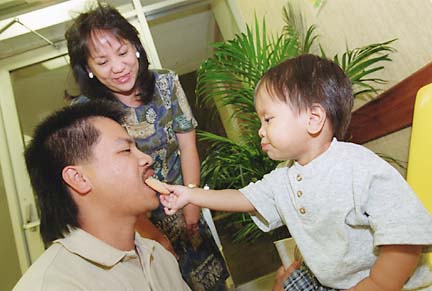


UH schools there
when ailing infant
needed them
A pediatrician says the
UH president gets an earful.
medical and public health
programs play vital roles
Student reflects on regents' role.By Helen Altonn
Star-BulletinIf you saw 2-year-old Jonah Saem running and playing, you'd think he was like any other child his age, said his mother, Kristen Castillo-Saem.
What you don't see is the tube in the infant's stomach. He's on a special feeding pump eight hours every night.
The first child of Kristen and Castor Saem, both 30, Jonah was born May 11, 1997, at Kapiolani Hospital. He was 10 weeks premature.
Dr. Arleen Jouxson-Meyers, the Wahiawa family's pediatrician, cited Jonah's case as an example of the importance of the University of Hawaii's medical and public health schools.
"He probably would not have survived without the presence of the medical school," Meyers said. And the school of public health, "among many other things it does, develops programs to try to prevent and cut down premature pregnancies," she said.
Jonah was in Kapiolani's neonatal intensive care unit for six months under the care of doctors who are UH faculty members, Meyers said.
One was Dr. Claire Wilson, pediatric gastroenterologist specialist at Kapiolani and assistant professor of pediatrics.
Meyers said there would have been no teaching professors at Kapiolani Hospital to take care of Jonah if there was no medical school.
She said technology in neonatal care and management of Jonah's type of condition have changed rapidly over the years. The doctors with that knowledge wouldn't be here if they weren't medical school faculty members, she said.
Jonah weighed 3 pounds and 10 ounces at birth, which isn't as small as some premature babies, Meyers said. "Now, sometimes 1-pounders survive."
But Jonah developed a condition called necrotizing enterocolitis, which affects the bowel in premature babies, Meyers said. "He ended up having a large chunk of intestine surgically removed."
Because of the child's short bowel syndrome, he couldn't swallow food and initially had to be drip-fed 24 hours a day through a tube in his stomach, Meyers said.

New techniques have led such children to survival through the first rough years, Meyers said. "They come out of this completely intellectually and developmentally normal."Because of his remaining intestine, Jonah is expected to be off the tube within a few years and able to eat normally, she said.
Castillo-Saem said the doctors are trying to wean him off the machine but he needs a steady gain in weight, which has been fluctuating. He's now about 23 pounds.
"He is having foods by mouth, but it's all about whether his system can tolerate it," she said. A dietitian monitors his weight and what he's fed, she said.
He's allergic to milk and some other things, she said. "That's where the machine helps a lot, to slowly drip it into him."
Jonah also has diarrhea during the day, which is "going to be normal for him," his mother said.
She said Jonah takes vitamin E shots once a month and goes to physical therapy to help with muscle development.
She and her husband are pleased with his progress but thought by now he would be off the pump, she said. "He's been having some setbacks."
He's prone to stomach viruses with drip-feeding and loses a lot of weight, she said. "We haven't been able to get past the eight-hour mark."
Jonah no longer tries to pull out the tube. "Now he's at the age where he knows it hurts him," his mother said.
But she said, "We have to sneak him on the machine, when he's out cold sleeping. If we try to put him on when he's awake, he throws a fit."
The couple is hoping Jonah will be off the pump by the time he goes to school.
"Meanwhile, we're not rushing him," said Castillo-Saem. "We're just thankful there's something that could help him through this."
Jonah spent most of his first year in the hospital. He was home for about a month after his first six months in the neonatal unit, then had to be hospitalized an additional two months.
"Different intern doctors came in and asked me all kinds of questions about Jonah and what was going on," Castillo-Saem said. "In that way, I felt really good, knowing they can apply what they're learning to another child.
"I could relate with those local doctors, too. They would talk to me so I could understand them and vice versa."
Castillo-Saem is employed at Honolulu Cellular and her husband works at Contractors Equipment and Service Corp.
They attended a meeting last night at Wahiawa General Hospital sponsored by the Hawaii Coalition for Health to discuss the community impact if the UH medical and public health schools were to close.
Three other meetings are scheduled for this month.
"I can support them and tell them the story about Jonah," said Castillo-Saem.
http://www.kaleo.org
KA LEO: Student fights for school's future